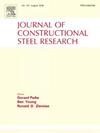Buckling analysis of structures containing cutouts using non-uniform spline finite strip method
IF 4
2区 工程技术
Q1 CONSTRUCTION & BUILDING TECHNOLOGY
引用次数: 0
Abstract
Cutouts are commonly found in engineering structures for purposes such as transportation and access. The existence of cutouts disrupts the overall stiffness distribution and structural integrity, posing a threat to the buckling resistance of thin-walled structures. In this paper, a new and unique non-uniform spline finite strip method (N-u SFSM) for buckling analysis of perforated structures is developed. The incorporation of non-uniform spline functions effectively overcomes the inherent absence of local modification in the traditional finite strip method (FSM), enabling precise modeling and local mesh refinement of cutouts for accurate predictions of buckling behaviors. The convergence and validation studies confirm the accuracy of the developed N-u SFSM for buckling analysis of structures featuring cutouts. Furthermore, by optimizing the spline interpolation points, the number of knots is reduced, and the computational efficiency is significantly improved compared to the existing spline finite strip method (SFSM). The versatility of the method is demonstrated by its effective use in both the perforated plates and cylinders, where diverse configurations of cutouts in terms of size, shape, quantity, and location are analyzed. In conclusion, the present study presents a highly efficient and applicable finite strip method that can be locally refined for analyzing the buckling characteristics of perforated structures.
求助全文
约1分钟内获得全文
求助全文
来源期刊

Journal of Constructional Steel Research
工程技术-工程:土木
CiteScore
7.90
自引率
19.50%
发文量
550
审稿时长
46 days
期刊介绍:
The Journal of Constructional Steel Research provides an international forum for the presentation and discussion of the latest developments in structural steel research and their applications. It is aimed not only at researchers but also at those likely to be most affected by research results, i.e. designers and fabricators. Original papers of a high standard dealing with all aspects of steel research including theoretical and experimental research on elements, assemblages, connection and material properties are considered for publication.
 求助内容:
求助内容: 应助结果提醒方式:
应助结果提醒方式:


